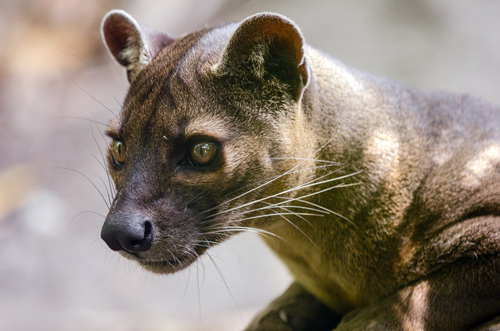By SURIAUNNA BIRMINGHAM
Sheridan High School Student

The Sheridan Student Column is brought to readers by Sheridan High School’s 10th grade English class, taught by Abby Williams.
Fossas are not the most well-known animal, but in Madagascar they are seen often. They live in every part of Madagascar but tend to stick to the forests. Fossas particularly like humid or dry areas. They colonized the island between 18 and 20 million years ago. This species is considered vulnerable by the Endangered Species Act (ESA).
Appearance
The Fossa has a slender body and a long tail that resembles a mongoose. Their name comes from the Greek word cryptoprocta which means “hidden anus.” Similar to squirrels and cats, Fossas have semi-retractable claws. This helps them move swiftly through the trees while climbing.
Location & population
Even though there are 2,500 Fossas left in the wild, the villagers are not a fan of the creature and do little to protect them. They see Fossas as pests and consider them dangerous. Furthermore, the children hear stories of Fossas killing all the chickens and diminishing fires. This causes the villagers to eliminate any Fossa that comes near.
Another reason the Fossa population is steadily decreasing is due to 90 percent of forests being removed. At the current rate of deforestation, by 2060 all forests in Madagascar will be gone. Although Fossas have no natural predators, humans pose a hazard. They have a defense mechanism that helps against humans. When Fossas are threatened, they release an unpleasant scent that scares predators away.

Photo provided / Wikimedia Commons
Diet
Over 50 percent of the Fossa’s diet consists of lemurs while rodents and lizards are at 9 percent, seeds at 5 percent and birds at 2 percent. They hunt both on the ground and in trees. Fossas hunt in a pattern known as cathermal. This means they peak at certain times of the day, normally in the morning, afternoon, and evening.
Breeding & development
Fossa’s breeding is very intriguing. While a female is sitting up in a tree, she waits for a male. Once one comes, she decides if it is dominant enough to mate with. Females typically gestate for three months, or 93 days. Offspring numbers are usually two to four but on rare occasions, six. The babies are born with no fur or teeth and weigh 3.5 ounces. Development is often slow, and the pups are with their mother for one to two years.
Taxonomy
The Fossa can be pronounced in many different ways: Fuh-Sah, Foo-sah and foosha. According to the San Diego Zoo Wildlife Alliance Library, the origins also come from France (cryptoprocta), Spain (Gato fossa de Madagascar) and Malagasy (Kava’hy and Kintsa’laViro (Richardson). The taxonomy order is Animalia, Chordata, Mammalia, carnivora, Eupleridae, Cryptoprocta Chenu, Eupleres, Chryptoprocta Bennett and Cryptoprocta Feres Bennett. There is only one species of Fossa and limited variations to size and appearance (Wikipedia). The mongoose and fossa evolved from the same ancestor which arrived about 21 million years ago to Madagascar.

